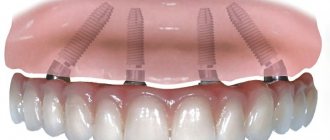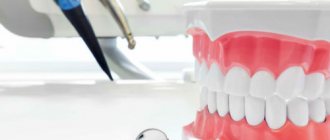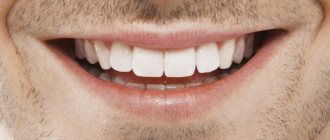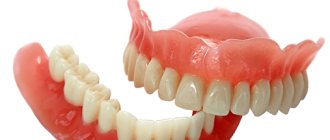A beautiful smile undoubtedly matters to a person. After all, this is what many people fix their attention on when they meet. A smile leaves an unforgettable impression on the interlocutor. It plays an important role in your confidence when communicating. A beautiful smile will improve contact with your interlocutor, improve behavior and leave behind all sorrows and self-doubt, and will also melt the heart of any stranger. But if the smile is not perfect and there is a defect in the front teeth (cracked dental plate, extracted tooth, crooked bite or tooth fragment, caries), how can we talk about self-confidence? Such a person will become isolated from others, become withdrawn, stop smiling, and will feel awkward when communicating. All this can leave a mark on a person’s profession and on his personal life.
No one wants to show problems with their front teeth to others, so dentures are the best solution for such patients.
When performing prosthetics after removal, it is important to restore and preserve the functions of the organ:
- Correct bite;
- Shape;
- Natural color;
- Gum health.
Prosthetics of the front teeth is also an aesthetic issue, therefore, to create a beautiful smile, it is necessary to use high-quality, durable materials that will visually look good. In dentistry, several methods of installing dentures are used and leading materials are used to give each patient a dazzling smile.
The main indications for the use of anterior dental prostheses are:
- Cracks in the dental plate, chips, broken teeth;
- Lost teeth or congenital adentia;
- Carious teeth;
- Crooked bite;
- Yellowing or darkening of the enamel;
- Crooked teeth, irregular shape and uneven “facial” surface of the tooth;
- Early unsuccessful prosthetics.
To solve your problem and select the correct method for installing dentures after removing your front teeth, you can consult the Dr. Levin dental clinic by calling the clinic.
Prosthetic options for anterior teeth
- Temporary and permanent;
- Removable and non-removable.
Temporary prostheses are needed for emergency filling of the defect. This option is performed for a broken tooth, extraction, and when removing or replacing other dentures. To do this, temporary plastic prostheses or removable dentures are used to close the existing defect. The wearing period of such implants is 30-60 days. This time will be enough to make a permanent prosthesis and sanitize the oral cavity.
Permanent prosthetics are performed after the root implant has healed, with healthy neighboring teeth, and in the absence of inflammatory changes in the oral cavity.
Removable prosthetics can be used in people who, due to contraindications, cannot currently perform such a procedure and it is postponed for some time. Or when it is not possible to install a prosthetic bridge due to the lack of more than four teeth in a row or the supporting teeth are damaged. Such patients are recommended to wear removable dentures.
Fixed prosthetics are carried out according to indications and include the following techniques:
- Implantation;
- Bridge prosthetics;
- Installation of crowns;
- Installation of veneers or lumineers.
There are several options for prosthetics of the upper and lower front teeth
Crowns: what are they?
Depending on the composition they have indications and contraindications. Many people wonder how they are made and what they consist of dentures and their parts. Let's look at each type separately.
Metal
There are cast and stamped. They are widespread due to their low cost, as well as ease of implantation and maintenance, but have lost their relevance due to the use of more modern analogues.
They can be made of nickel, titanium, gold, silver, cobalt. The downside is complete unattractiveness.
Plastic
They are made with or without a finished frame. Attractive and beautiful design, together with simple and cheap installation, can make them leaders in application. Low strength and fragility are the main disadvantages of polymer dentures and structures. In addition, plastic is a highly allergenic component.
Used for restoration, correction of anterior incisors (low load) and temporary solutions, while a permanent option is in development.
Metal-ceramic
Metal base, in the upper layers of which a ceramic coating is applied. The most common: ideal price-quality ratio. Strength, durability, the ability to be inserted into any place are advantages. The disadvantages include a possible change in color over time (requires additional care and protection), may be rejected or lead to inflammation of the gums.
Porcelain
Porcelain implants are made using press casting followed by firing. Aesthetic, strong and durable, while completely anti-allergenic. However, the high price threshold greatly reduces the application.
Zirconium dioxide crowns
After smelting, they are able to completely copy the natural external structure of the teeth. The high cost and the impossibility of subsequent adjustments after smelting the structure make this material rare. However, high strength and durability are its advantages.
Implantation of artificial teeth
A modern, long-lasting option for the restoration of front teeth is implantation. This operation involves inserting a special pin into the jaw bone, in the place where a tooth is missing, which will act as a tooth root and will counteract atrophic changes in bone tissue. This pin is made of titanium and does not cause any inconvenience or complications in the future. Then a crown made of ceramic is installed on this titanium rod. Implantation makes it possible not to touch the healthy teeth in the neighborhood. For this procedure, high-quality durable implants from the Nobel Biocare brand are used, which are guaranteed for life. The implanted tooth will not differ in any way from the rest, since the crown is made after measurement and exactly matches the shape and natural shade of the teeth. Another technique for using dentures on the front teeth is installing a bridge.
The name “bridge” was borrowed from technicians, since its installation uses the principle of constructing bridges. A bridge is a type of permanent dental prosthesis; they are used to replace defects of several teeth (up to four) in a row. To do this, special crowns are installed on the adjacent good teeth, between which the prosthesis will be placed. The negative quality of this technique is the need to grind down the surface and remove the pulp of healthy teeth on which crowns will be placed. The bridge also needs to be replaced at least once every few years. But with these disadvantages, this method allows you to avoid surgical intervention.
Types of prostheses
1. Fixed prostheses, which include single crowns, as well as structures based on crowns - bridge and cantilever prostheses; they can be plastic, metal, ceramic, or a combination of these materials. When planning fixed dentures, the specialist strictly takes into account the safety factor of the periodontium of the supporting teeth, the expected load on the product itself and the teeth used under it.
2. Removable dentures. Regardless of whether plate or clasp structures are used, the main advantage of removable prosthetics is the absence of the need to treat the teeth holding the prosthesis and the gentle load, since the main part of the chewing pressure is transferred by the prosthesis to the edentulous part of the alveolar process of the jaw.
3. Conditionally removable dentures - structures that are a type of partial removable dentures that are applied directly to the mucous membrane of the alveolar process and are held in place by means of locking fasteners inextricably linked to one or more crowns. When dental prosthetics are made with conditionally removable structures, the supporting teeth are also not overloaded, however, they make it possible to obtain good fixation when making a prosthesis only for a small part of the dentition, and not for the entire jaw.
Prosthetics of anterior teeth using crowns
Sometimes lesions on the front teeth can be more serious. Then prosthetics of the front teeth using crowns is suitable. To make the most natural shape of the tooth being installed and to ensure a tight fit of the crown, it is necessary to grind the affected tooth and, if necessary, remove the pulp and nerve. Then process and seal the canals. After fitting, a ceramic crown is installed on the dental cement mortar. Ceramic or zirconium structures without metal are best suited for dental prosthetics.
The main advantages of such crowns are:
- The base from which the dentures are made must be hypoallergenic. Which is very important. Ceramic crowns do not cause allergic reactions.
- Ceramic crowns look aesthetically pleasing. Based on individual measurements and subsequent fitting, you can ideally select the desired shape and color that will match the natural shade of natural teeth.
- Metal-free crowns do not cause darkening of the gums around the installed tooth and do not leave a metal rim. They also do not lead to alveolitis, gingivitis and periodontitis.
- Ceramic crowns will not cause discomfort when eating food at different temperatures.
- Also, such crowns are lightweight, comfortable and durable.
Types of dental crowns for chewing teeth
When choosing a material for creating a microprosthesis, you should take into account the functional purpose of the teeth. The molars of the posterior zone of the dentofacial apparatus are subjected to strong mechanical and chemical stress when chewing food.
Eating food that differs in taste, composition and hardness can quickly damage the nozzle, which is made of aesthetic material, but vulnerable to the abrasive properties of some products. In addition, the material should not cause allergies to the soft tissues of the oral cavity.
Therefore, it is better to entrust the choice of material for making crowns to a specialist.
Prosthetic replacement of anterior tooth after extraction
After tooth extraction, it is better to do its prosthetics using the express implantation technique, in the absence of contraindications. To do this, immediately after tooth extraction, an implant and a special abutment are installed in its alveolar socket to form the correct gum shape. A crown is temporarily placed on it. After the implant has healed for approximately several months, a permanent crown is installed.
The advantages of express implantation include:
- This procedure does not require any additional incisions, which is less traumatic to the gums;
- The implant is installed in an open manner, which also does not require additional surgical intervention;
- This method is perfect for patients who do not want to wait until the hole heals and a bridge or crown can be installed.
- Short healing period;
- There are few side complications that are unpleasant for the patient.
Why you can't hesitate
Not everyone sees tooth loss as a tragedy. Some people live for years without several teeth and get used to it. But this is wrong, because a tooth that falls out for one reason or another is not only a cosmetic problem, but also a medical problem. It is necessary to fill the vacated space as soon as possible.
One tooth missing in a row
The first thing people who have lost teeth encounter is the so-called “slipping of teeth.” The bite shifts, and it may be uncomfortable for the person to close their teeth or chew with them. In some cases, when wisdom teeth grow, the teeth can shift and take up the free space - this also affects the condition of the bite.
Change in bite after tooth extraction
Sometimes a lost tooth causes nearby teeth to come into contact with each other. Since there is free space between them, they move there and may grow incorrectly. As a result, the teeth become abnormally positioned, they are difficult to clean, and other teeth may also be lost.
For these reasons, dentists strongly recommend replacing lost teeth with new ones as soon as possible.
Installation of dentures for anterior teeth without turning
This is the restoration of damaged teeth, when the neighboring teeth intended for support are not ground down or depulped. In this case, it is worth performing implantation. This is one of the most gentle and atraumatic methods of installing upper and lower teeth. The essence of the method is that in the place of the lost tooth, an implant is installed in the jaw bone tissue, which performs the function of a root. Subsequently, a crown is put on it.
There are also methods that do not require grinding of a layer of healthy teeth, but they are rather temporary.
Veneers and Lumineers
Veneers and lumineers can be used as aesthetic options for dentures on the front teeth. Veneers are very thin shells of porcelain that are given a color similar to the natural color of the patient's teeth. Veneers completely match the shape of a natural tooth. Such plates are attached to the front surface of the tooth.
Lumineers are transparent and very thin plates about 0.15 mm thick. Placed on the front surface of the tooth. This cosmetic procedure is non-invasive, quick, painless and long lasting.
These qualities determine the indications for the installation of veneers or lumineers:
- Crack and small chip of a tooth;
- Yellowing or darkening of tooth enamel;
- Uneven frontal surface;
- Crooked teeth.
Stages of treatment
- Preparatory stage.
The doctor examines the patient and discusses possible treatment options with him. If the patient is ready for implantation, he is sent for additional examination: computed tomography (CT) and, if necessary, a blood test. - Drawing up an implantation plan.
The CT results are loaded into a special computer program that reproduces a 3D model of the patient’s jaw. On this model, the doctor marks the placement of implants. If there are a large number of missing teeth, a surgical template (a tray with holes through which the implants will be installed) is created in the laboratory in accordance with the developed plan. - Implantation of chewing teeth.
With the classical method, the implantologist peels off a gum flap and forms a bed in the bone in which the implant is secured. After which the gum is sutured. With the basal technique, implants are screwed into the bone through small punctures in the tissue. This operation does not require sutures. All manipulations take about 1-1.5 hours. - Prosthetics.
With basal implantation, impressions of the jaws are taken immediately after the implants are installed, and the prosthesis is installed within 2-4 days. According to the classic protocol, prosthetics are performed after 2-4 months.
Installation of prosthetic anterior teeth on the upper and lower jaws
The use of dentures for the lower and upper anterior teeth is almost the same from a practical point of view. The difference may lie in the fact that the installation of dentures for the upper teeth requires more attention from the dentist, since the upper jaw is somewhat less well supplied with blood than the lower jaw, hence healing here will take a little longer. And also, when a person smiles, the front teeth are the first to be seen from above, so it is necessary to pay more attention to the aesthetic side of prosthetics.
Preparing for dental prosthetics
Many people do not like any dental procedures, and this is due to the fear of unbearable pain. You should not be afraid of dental prosthetics, since the most unpleasant thing you will encounter is tooth grinding and depulpation. And all procedures are carried out using local, good, strong anesthetics.
An important diagnostic point is x-ray examination to determine the number and size of roots.
Other stages of preparation include the improvement of neighboring teeth (removal of plaque, treatment of carious damage), which will serve as a support for the prosthesis. If the tooth is significantly damaged, they resort to extraction, treatment of the canals and their subsequent filling.
For prosthetic treatment of anterior teeth, as for any other manipulation, there are contraindications. They are divided into absolute and relative.
Absolute contraindications include:
- 3-4 stages of cancer;
- Conditions after chemotherapy;
- Immunodeficiency conditions;
- Severe somatic diseases in the stage of decompensated state;
Relative:
- Diabetes mellitus (especially type 1);
- Diseases of the heart and blood vessels, such as hypertension with crisis and angina pectoris;
- Smoking, alcoholism;
- Mental disorders;
- Pregnancy;
- Allergic reactions to dental medications and materials.
Causes of tooth loss
The main reasons why teeth fall out.
| Cause | Description |
| Lack of proper treatment | An advanced case of caries, treatment not carried out on time or not carried out at all. |
| Poor oral hygiene | Irregular brushing of teeth, irregular preventive visits to the dentist. |
| Elderly age | Dental problems in people who have reached old age. |
| Injuries | Injury to a tooth or teeth, leading to their loss. |
| Diabetes | Diabetic patients often have problems with the dental system. |
| Genetics | Hereditary diseases of teeth and gums. |
| Gum diseases | Poor gum health, which causes the bones that support the teeth in place to weaken. |
The main problems that can result in a person losing teeth are listed. But we must remember that with the current state of dentistry, this problem can be solved if you choose the right option for replacing teeth.











